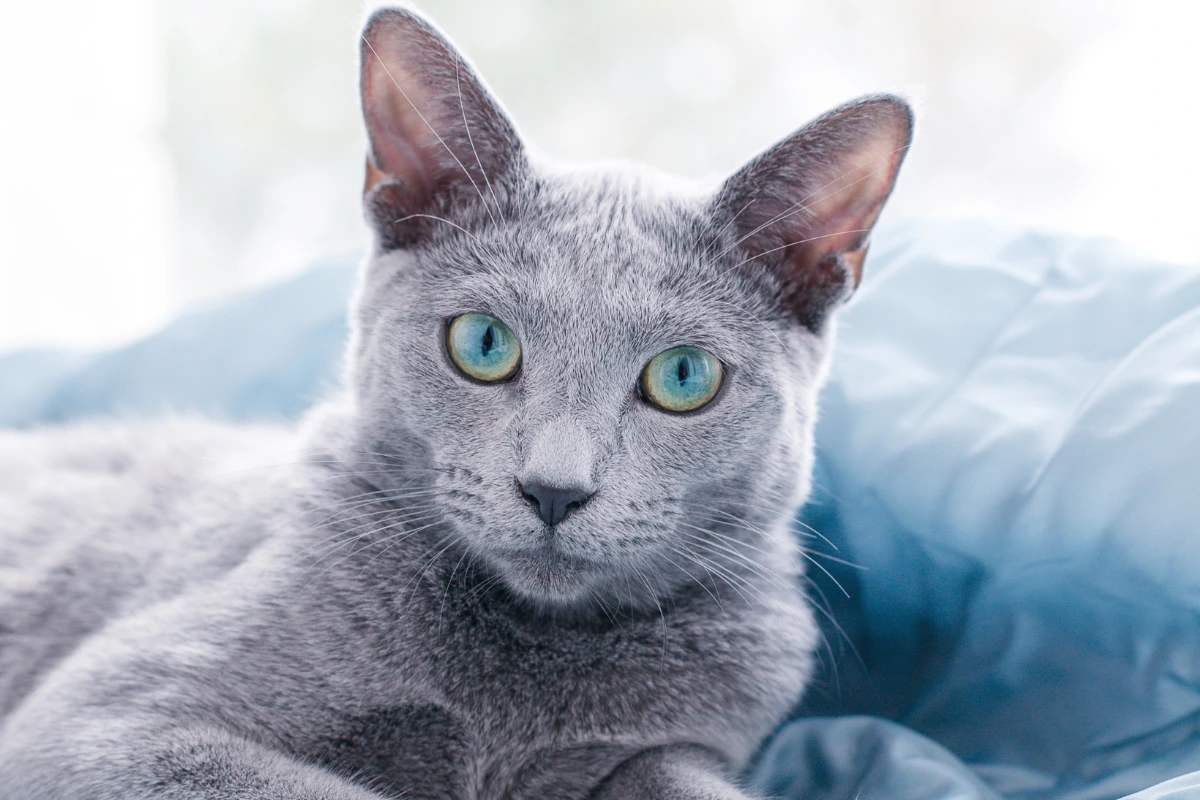Russian Blue cat adoption offers a rewarding experience for any cat lover. This elegant breed is known for its striking blue-gray coat, emerald-green eyes, and affectionate nature. Many people choose adoption because it provides a loving home to a cat in need while avoiding the high costs of purchasing from a breeder.
Russian Blue cats are intelligent, gentle, and highly loyal to their owners. They adapt well to various home environments, making them a great choice for families, singles, and seniors. Their hypoallergenic qualities and minimal grooming needs add to their appeal. Understanding why adoption is the best choice helps potential owners make an informed decision.
1. Russian Blue Cats Have a Gentle and Loyal Personality
Known for Their Affectionate and Calm Nature
Russian Blue cats are famous for their gentle and affectionate temperament. Unlike some high-energy breeds, they enjoy a peaceful and predictable environment. Their calm nature makes them easy to live with, as they rarely exhibit aggressive or overly demanding behavior. They love spending time with their owners but also appreciate their independence. Russian Blues often greet their favorite people at the door, showing quiet affection through soft purring and gentle head bumps.
They Form Strong Bonds with Their Owners
Russian Blue cats develop deep, loyal connections with their human companions. They may be shy around strangers at first, but once they trust someone, their devotion lasts a lifetime. These cats often follow their owners from room to room, offering companionship without being clingy. Many Russian Blue owners describe their cat as a constant presence, offering silent support and affection. Their intelligence also allows them to recognize their owner’s routines, making them highly intuitive pets.
Ideal for Families, Singles, and Seniors
This breed’s adaptable nature makes it suitable for various households. Families with children appreciate their patience and gentle playfulness, while singles find comfort in their loyal companionship. Seniors enjoy their low-maintenance care and affectionate personality without the overwhelming energy of more active breeds. Russian Blues thrive in homes where they receive love, attention, and a stable routine, making them an excellent choice for anyone looking for a devoted feline friend.
2. Adopting a Russian Blue Cat Is More Affordable Than Buying
Adoption Fees vs. Breeder Costs
Choosing Russian Blue cat adoption is often more affordable than purchasing from a breeder. Adoption fees typically range from $75 to $200, depending on the shelter or rescue organization. This fee usually covers essential services like vaccinations, spaying or neutering, and microchipping. Some shelters may also include a health check and basic supplies to help your new pet settle in.
In contrast, buying a Russian Blue cat from a breeder can cost anywhere between $800 and $2,500, depending on the cat’s lineage, age, and location. While breeders may provide pedigree papers and early socialization, the high cost does not always guarantee better health or temperament. By adopting, you not only save money but also provide a loving home to a cat in need.
Adoption remains a cost-effective and compassionate option for those who want to welcome a Russian Blue into their lives.
What’s Included in an Adoption Package
When adopting a Russian Blue cat, most shelters and rescue organizations provide an adoption package that includes essential veterinary care. This often covers spaying or neutering, vaccinations, microchipping, and a basic health check. Some organizations may also provide flea treatments, deworming, and a starter pack of food or supplies to help the cat adjust to its new home. These services significantly reduce initial pet care expenses, making adoption an affordable and convenient choice.
Supporting Shelters and Rescue Organizations
By adopting a Russian Blue, you directly support shelters and rescue groups that work tirelessly to care for abandoned or stray animals. Adoption fees help cover medical expenses, food, and shelter for other cats in need. Choosing adoption also helps reduce the number of cats in overcrowded shelters, giving more animals a chance to find loving homes. Many rescues specialize in rehoming specific breeds like the Russian Blue, ensuring that these cats receive proper care before joining their forever families.
3. Russian Blue Cats Are Low-Maintenance and Easy to Care For
Minimal Grooming Needs Due to Short, Dense Fur
Russian Blue cats have a plush, double-layered coat that feels soft and velvety. Despite its density, their fur does not mat easily, making grooming simple. A weekly brushing session is usually enough to remove loose hairs and keep their coat looking healthy. Unlike long-haired breeds that require frequent brushing and detangling, Russian Blues maintain their sleek appearance with minimal effort. Their natural grooming habits also help keep them clean, reducing the need for frequent baths.
Generally Healthy Breed with Fewer Vet Visits
Russian Blues are known for their robust health and longevity, often living between 15 to 20 years with proper care. Unlike some purebred cats that suffer from hereditary conditions, this breed has fewer genetic health issues. They are less prone to respiratory problems and joint disorders, reducing the likelihood of frequent vet visits. Routine checkups, vaccinations, and a balanced diet help maintain their well-being, making them a low-maintenance breed in terms of medical care.
Suitable for First-Time Cat Owners
The Russian Blue’s calm temperament, independent nature, and easy-care requirements make them an excellent choice for first-time cat owners. They quickly adapt to a routine, enjoy interactive play but do not demand constant attention, and use the litter box with little to no training. Their quiet and well-mannered personality also makes them ideal for apartment living. With their affectionate yet undemanding nature, Russian Blues offer a smooth and rewarding experience for new pet owners.
4. They Are Hypoallergenic and Great for Allergy Sufferers
Produce Less Fel d 1 Protein (Common Allergen)
Russian Blue cats are often considered a better choice for allergy sufferers because they produce lower levels of Fel d 1, the protein responsible for triggering cat allergies. While no cat breed is completely hypoallergenic, Russian Blues shed less dander compared to many other breeds. This means they may cause fewer allergic reactions in sensitive individuals. Their short, dense coat also helps trap allergens, reducing the amount released into the home.
Tips for Managing Allergies Around Cats
Even with a lower production of Fel d 1, some people may still experience mild allergic reactions. To minimize symptoms, consider the following tips:
- After you touch your cat, be sure to wash your hands. This helps stop allergens from getting on your face.
- Use an air purifier with a HEPA filter to reduce airborne allergens.
- Create cat-free zones in bedrooms or other areas where you spend a lot of time.
- Bathe or wipe your cat with a damp cloth occasionally to remove allergens from their fur.
Best Practices for Keeping a Clean Home with a Russian Blue
Maintaining a clean environment helps reduce allergens and keeps your home fresh. Here are a few best practices:
- Vacuum frequently using a vacuum with a HEPA filter to trap pet dander and hair.
- Wash bedding and furniture covers regularly to prevent allergen buildup.
- Brush your Russian Blue weekly to control shedding and keep their coat healthy.
- Use hypoallergenic cat litter to reduce airborne dust and allergens.
By following these steps, allergy sufferers can enjoy the companionship of a Russian Blue cat while keeping their symptoms under control.
5. Russian Blue Cats Thrive in a Loving, Indoor Environment

Prefer a Quiet, Stable Home Setting
Russian Blue cats thrive in calm and predictable environments. They are sensitive to sudden changes and loud noises, so a peaceful home helps them feel secure. Unlike more social or outgoing breeds, Russian Blues may take time to warm up to new people and situations. They prefer a stable routine and consistent interaction with their owners. Providing a quiet space where they can retreat when feeling overwhelmed helps them feel safe and comfortable.
Easily Adapt to Apartment Living
Their independent nature and moderate activity level make Russian Blues well-suited for apartment living. They do not require a lot of space to be happy, as long as they have cozy spots to relax and areas to explore. Unlike highly energetic breeds that need large play areas, Russian Blues enjoy observing their surroundings from a comfortable perch or engaging in interactive play sessions. Their quiet demeanor also makes them ideal for apartment dwellers who want a low-noise, low-maintenance pet.
Russian Blue Cat Adoption: How to Create a Cat-Friendly Space
Making your home cat-friendly ensures that your Russian Blue stays entertained and comfortable. Consider these tips:
- Provide vertical spaces like cat trees or shelves for climbing and lounging.
- Offer cozy hiding spots such as covered beds or quiet corners for resting.
- Use scratching posts to satisfy their natural scratching instincts and protect furniture.
- Set up interactive toys to keep them mentally stimulated and prevent boredom.
- Ensure a clean litter box in a private location to maintain good hygiene and comfort.
By creating a space that meets their needs, Russian Blues can live happily in any home, whether it’s a small apartment or a larger house.
6. Giving a Russian Blue Cat a Forever Home Saves a Life
The Importance of Pet Adoption
Pet adoption plays a vital role in giving animals a second chance at a loving home. Many cats, including Russian Blues, end up in shelters due to circumstances beyond their control, such as owner relocation or financial difficulties. By choosing adoption, you provide a safe and caring environment for a cat in need. Adoption also helps reduce overcrowding in shelters and supports ethical pet ownership by discouraging irresponsible breeding practices.
How Shelters and Rescues Help Abandoned Cats
Animal shelters and rescue organizations work tirelessly to care for abandoned and stray cats. They provide essential services such as medical care, vaccinations, spaying or neutering, and behavioral assessments to ensure cats are healthy and ready for adoption. Breed-specific rescues focus on finding suitable homes for Russian Blue cats and often have experienced volunteers who understand the breed’s unique needs. By adopting from a shelter or rescue, you support their efforts and help other animals receive the care they need.
Where to Adopt a Russian Blue
Finding a Russian Blue cat for adoption may take time, but several options exist:
- Local animal shelters often have mixed-breed cats with Russian Blue characteristics. Visiting in person or checking online listings can help locate one.
- Breed-specific rescues specialize in purebred Russian Blues and have adoption programs that match cats with the right homes.
- Online pet adoption websites such as Petfinder and Adopt-a-Pet list available Russian Blue cats from shelters and rescues across the country.
- Cat foster programs provide temporary homes for cats before adoption, allowing potential owners to meet and interact with them before making a decision.
Choosing adoption not only brings a loving companion into your life but also makes a meaningful difference in the lives of animals in need.
Conclusion
Adopting a Russian Blue cat comes with many benefits. Their affectionate yet independent nature, low-maintenance grooming, and strong bond with their owners make them an ideal companion for families, singles, and seniors. They adapt well to apartment living, have fewer health concerns than some other breeds, and even produce lower levels of allergens. Choosing adoption over buying from a breeder also helps support shelters and gives a cat in need a loving home.
If you are considering bringing a Russian Blue into your home, adoption is the best way to do it. Shelters and breed-specific rescues work hard to find these cats the right homes, and by adopting, you make a real difference in an animal’s life.
To start your adoption journey, check local shelters, breed-specific rescues, and online pet adoption websites like Petfinder, Adopt-a-Pet, and The Russian Blue Rescue Group. Giving a Russian Blue a second chance means gaining a lifelong, loyal companion.

